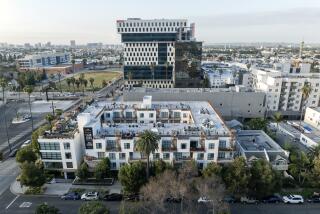State’s Economy Suffers Body Blows : Devastation: The quake could give impetus to other states’ efforts to lure investment away from California. But the state will also have a chance to show its resilience.
The late Henry J. Kaiser, perhaps the San Francisco Bay Area’s most illustrious industrialist, used to say: “There is no such thing as a problem, only an opportunity.” The earthquake that devastated the Bay Area on Tuesday will give the region and the state a chance to test that theory in spades.
For Kaiser, World War II was the opportunity to build an industrial empire on his ability to turn out ships at the rate of almost one a day. For Northern California leaders today, the challenge is to prevent the long-term economic devastation that could result from the severing of major transportation arteries in the Bay Area.
The current generation of Northern Californians grew blase about earthquakes, viewing them much like rides on the giant roller coaster at the Santa Cruz Boardwalk. Unlike all the other shakers that have hit the Bay Area since 1906, Tuesday’s disaster will change the entire fabric of life for many of the region’s citizens.
Even without the quake, the Bay Area was suffering from severe traffic tie-ups, approaching gridlock. The earthquake collapsed a section of the San Francisco-Oakland Bay Bridge and freeway segments on both sides of San Francisco Bay--the arteries that connect San Francisco with suburbs to the south and east. This traffic flow is vital to the economy of the region.
State and local officials, taking an excursion into uncharted waters, must find ways to keep the region’s institutions functioning during the recovery period. No amount of planning could have prepared state and local officials for the blows suffered by the area’s already-overburdened highway system. Will the reconstruction effort strain government budgets? Will large corporations be able to keep their work force employed and adjust for transportation delays? Will small businesses, which depend heavily on tourism, be able to survive? Will financial institutions be willing to provide the capital needed to keep the area healthy?
San Francisco had already lost its status as the financial center of the West to Los Angeles, with a steady shift of economic power south over the past decade. That shift could accelerate if the nation’s corporate leaders aren’t shown that the Bay Area can cope with crisis. Even more ominous to the state’s economy, the quake could be used by other states in their “Anywhere but California” campaign to win major investments that otherwise might be made in the Golden State.
In recent years, high technology has been the economic engine that has run the Bay Area. Silicon Valley, close to the quake epicenter, could be put at economic risk if computer companies worry about transportation problems and possible temblors when deciding where to invest expansion dollars. Computer firms could be hit especially hard by the transportation bottlenecks, because workers travel long distances to work in the Palo Alto-Sunnyvale area.
There are other possible economic consequences:
--Construction could become more expensive as building codes are stiffened. This could make real estate even more expensive and force people to seek affordable housing even farther from their jobs.
--Delivery of goods could become difficult and expensive. Trucks will have to use circuitous routes to pick up and deliver.
--Investors could become leery of California because of the quake risk, which is extremely expensive to insure against. The cost of government bond borrowing could rise, placing an additional long-range burden on all the state’s taxpayers.
--Except for voyeurs, tourists could stay away from California in droves, because many Easterners don’t know the difference between Anaheim and Alameda.
--Politically, the earthquake could guarantee public approval of the major transportation program--including a gas tax increase--scheduled for next year’s ballot. The clean-up operation also could be an opportunity for some of the state’s politicians, notably Mayor Art Agnos of San Francisco, to demonstrate strong leadership--a commodity that has recently been in short supply in California.
Every Californian in one way or another will feel the economic brunt of Tuesday’s earthquake. In the short run, the financial effects will be mostly negative. But an entire region pulling together to minimize the damage could be beneficial in human terms for a society marked more by avarice than altruism. As Bruce Pearson, a Walnut Creek executive, pointed out, “Everybody has to pull together or we are going to have a horrendous mess for a long time.”
And there are definite opportunities. Of necessity, many Northern California commuters will be forced out of their autos and into the trains of the Bay Area Rapid Transit (BART) system--a shift public officials have been attempting to engineer for decades. The result could be a substantial permanent increase in BART ridership.
If Henry J. Kaiser were alive, he’d undoubtedly be pushing for the state to convert tragedy into opportunity by building a Northern California transportation system that would end the fear of gridlock through the next century.
More to Read
Start your day right
Sign up for Essential California for news, features and recommendations from the L.A. Times and beyond in your inbox six days a week.
You may occasionally receive promotional content from the Los Angeles Times.






